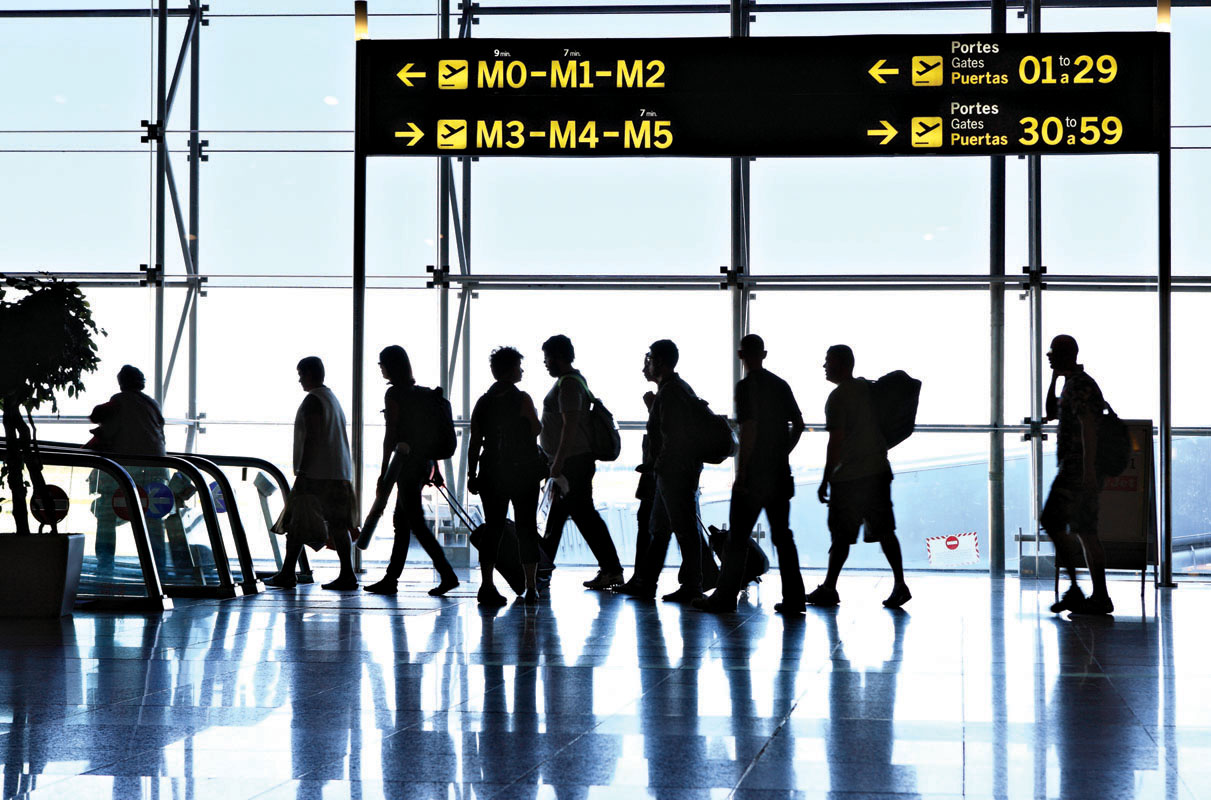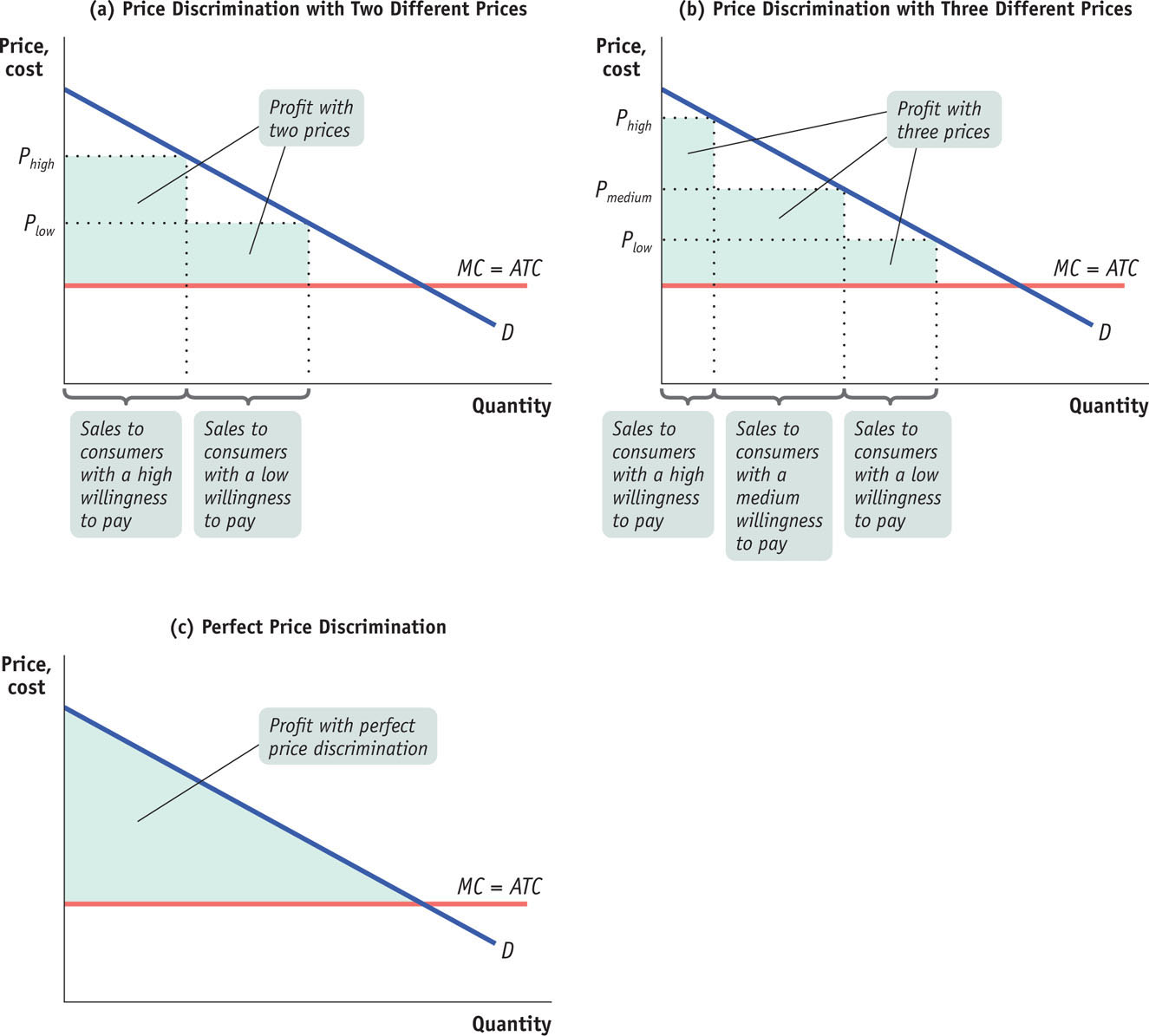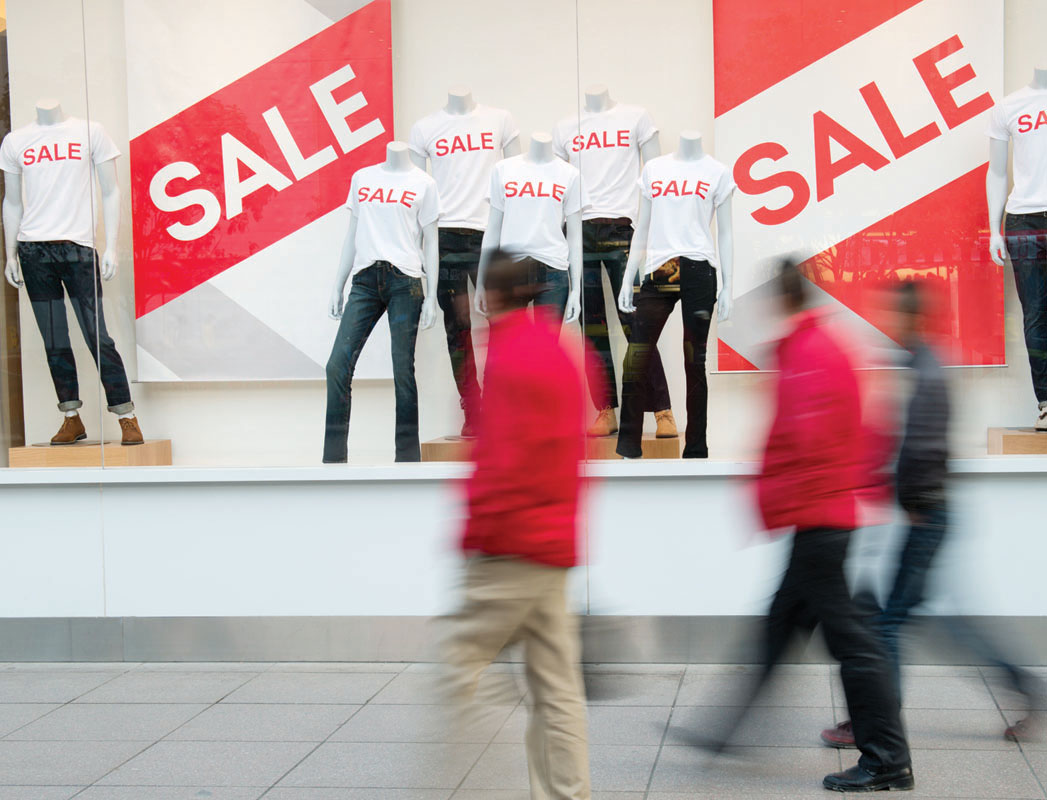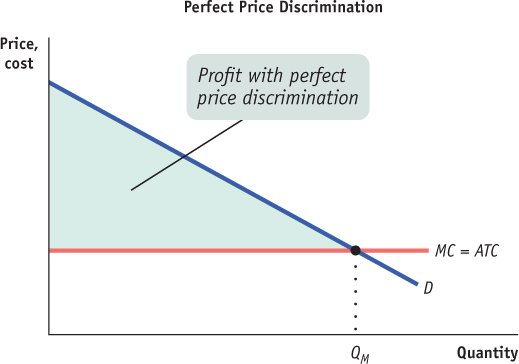1.3 30Price Discrimination

WHAT YOU WILL LEARN
 The meaning of price discrimination
The meaning of price discrimination
 Why price discrimination is so prevalent when producers have market power
Why price discrimination is so prevalent when producers have market power
Up to this point, we have considered only the case of a monopolist who charges all consumers the same price. However, monopolists want to maximize their profits and often they do so by charging different prices for the same product. In this module we look at how monopolists increase their profits by engaging in price discrimination.
Price Discrimination Defined
A single-
Sellers engage in price discrimination when they charge different prices to different consumers for the same good.
A monopolist that charges everyone the same price is known as a single-
An example of price discrimination that travelers encounter regularly involves airline tickets. Although there are a number of airlines, most routes in the United States are serviced by only one or two carriers, which, as a result, have market power and can influence prices. So any regular airline passenger quickly becomes aware that the simple question “How much will it cost me to fly there?” rarely has a simple answer.
If you are willing to buy a nonrefundable ticket a month in advance and stay over a Saturday night, the round trip may cost only $150—
You might object that airlines are not usually monopolies—
The Logic of Price Discrimination
To get a preliminary view of why price discrimination might be more profitable than charging all consumers the same price, imagine that Air Sunshine offers the only nonstop flights between Bismarck, North Dakota, and Ft. Lauderdale, Florida. Assume that there are no capacity problems—
Further assume that the airline knows there are two kinds of potential passengers. First, there are business travelers, 2,000 of whom want to travel between the destinations each week. Second, there are high school students, 2,000 of whom also want to travel each week.
Will potential passengers take the flight? It depends on the price. The business travelers, it turns out, really need to fly; they will take the plane as long as the price is no more than $550. Since they are flying purely for business, we assume that cutting the price below $550 will not lead to any increase in business travel. The students, however, have less money and more time; if the price goes above $150, they will take the bus. The implied demand curve is shown in Figure 30-1.
FIGURE30-1Two Types of Airline Customers

So what should the airline do? If it has to charge everyone the same price, its options are limited. It could charge $550; that way it would get as much as possible out of the business travelers but lose the student market. Or it could charge only $150; that way it would get both types of travelers but would make significantly less money from sales to business travelers.
We can quickly calculate the profits from each of these alternatives. If the airline charged $550, it would sell 2,000 tickets to the business travelers, earning a total revenue of 2,000 × $550 = $1.1 million and incurring costs of 2,000 × $125 = $250,000; so its profit would be $850,000, illustrated by the shaded area B in Figure 30-1. If the airline charged only $150, it would sell 4,000 tickets, receiving revenue of 4,000 × $150 = $600,000 and incurring costs of 4,000 × $125 = $500,000; so its profit would be $100,000. If the airline must charge everyone the same price, charging the higher price and forgoing sales to students is clearly more profitable.
What the airline would really like to do, however, is charge the business travelers the full $550 but offer $150 tickets to the students. That’s a lot less than the price paid by business travelers, but it’s still above marginal cost; so if the airline could sell those extra 2,000 tickets to students, it would make an additional $50,000 in profit. That is, it would make a profit equal to the areas B plus S in Figure 30-1.
It would be more realistic to suppose that there is some “give” in the demand of each group: at a price below $550, there would be some increase in business travel; and at a price above $150, some students would still purchase tickets. But this, it turns out, does not do away with the argument for price discrimination. The important point is that the two groups of consumers differ in their sensitivity to price—that a high price has a larger effect in discouraging purchases by students than by business travelers. As long as different groups of customers respond differently to the price, a monopolist will find that it can capture more consumer surplus and increase its profit by charging them different prices.
Price Discrimination and Elasticity
A more realistic description of the demand that airlines face would not specify particular prices at which different types of travelers would choose to fly. Instead, it would distinguish between the groups on the basis of their sensitivity to the price—
Suppose that a company sells its product to two easily identifiable groups of people—
The answer is the one already suggested by our simplified example: the company should charge business travelers, with their low price elasticity of demand, a higher price than it charges students, with their high price elasticity of demand.
The actual situation of the airlines is very much like this hypothetical example. Business travelers typically place a high priority on being in the right place at the right time and are not very sensitive to the price. But leisure travelers are fairly sensitive to the price: faced with a high price, they might take the bus, drive to another airport to get a lower fare, or skip the trip altogether.
So why doesn’t an airline simply announce different prices for business and leisure customers? First, this would probably be illegal. (U.S. law places some limits on the ability of companies to practice blatant price discrimination.) Second, even if it were legal, it would be a hard policy to enforce: business travelers might be willing to wear casual clothing and claim they were visiting family in Ft. Lauderdale in order to save $400.

So what the airlines do—
Because customers must show their ID at check-
Perfect Price Discrimination
Let’s return to the example of business travelers and students traveling between Bismarck and Ft. Lauderdale, illustrated in Figure 30-1, and ask what would happen if the airline could distinguish between the two groups of customers in order to charge each a different price.
Clearly, the airline would charge each group its willingness to pay—that is, the maximum that each group is willing to pay. For business travelers, the willingness to pay is $550; for students, it is $150. As we have assumed, the marginal cost is $125 and does not depend on output, making the marginal cost curve a horizontal line. And as we noted earlier, we can easily determine the airline’s profit: it is the sum of the areas of rectangle B and rectangle S.
Perfect price discrimination takes place when a monopolist charges each consumer his or her willingness to pay—
In this case, the consumers do not get any consumer surplus! The entire surplus is captured by the monopolist in the form of profit. When a monopolist is able to capture the entire surplus in this way, we say that the monopolist achieves perfect price discrimination.
In general, the greater the number of different prices charged, the closer the monopolist is to perfect price discrimination. Figure 30-2 shows a monopolist facing a downward-

- The greater the number of prices the monopolist charges, the lower the lowest price—
that is, some consumers will pay prices that approach marginal cost. - The greater the number of prices the monopolist charges, the more surplus extracted from consumers.
With a very large number of different prices, the picture would look like panel (c), a case of perfect price discrimination. Here, every consumer pays the most he or she is willing to pay, and the entire consumer surplus is extracted as profit.
Both our airline example and the example in Figure 30-2 can be used to make another point: a monopolist that can engage in perfect price discrimination doesn’t cause any inefficiency! The reason is that the source of inefficiency is eliminated: all potential consumers who are willing to purchase the good at a price equal to or above marginal cost are able to do so. The perfectly price-
FIGURE30-2Price Discrimination

Perfect price discrimination is almost never possible in practice. At a fundamental level, the inability to achieve perfect price discrimination is a problem of prices as economic signals. When prices work as economic signals, they convey the information needed to ensure that all mutually beneficial transactions will indeed occur: the market price signals the seller’s cost, and a consumer signals willingness to pay by purchasing the good whenever that willingness to pay is at least as high as the market price.
The problem in reality, however, is that prices are often not perfect signals: a consumer’s true willingness to pay can be disguised, as by a business traveler who claims to be a student when buying a ticket in order to obtain a lower fare. When such disguises work, a monopolist cannot achieve perfect price discrimination.
However, monopolists do try to move in the direction of perfect price discrimination through a variety of pricing strategies. Common techniques for price discrimination include the following:
- Advance purchase restrictions. Prices are lower for those who purchase well in advance (or in some cases for those who purchase at the last minute). This separates those who are likely to shop for better prices from those who won’t.
- Volume discounts. Often the price is lower if you buy a large quantity. For a consumer who plans to consume a lot of a good, the cost of the last unit—
the marginal cost to the consumer— is considerably less than the average price. This separates those who plan to buy a lot, and so are likely to be more sensitive to price, from those who don’t. - Two-
part tariffs. In a discount club like Costco or Sam’s Club (which are not monopolists but monopolistic competitors), you pay an annual fee (the first part of the tariff) in addition to the price of the item(s) you purchase (the second part of the tariff). So the full price of the first item you buy is in effect much higher than that of subsequent items, making the two-part tariff behave like a volume discount.
Our discussion also helps explain why government policies on monopoly typically focus on preventing deadweight loss, not preventing price discrimination—
Consider the case of consumers formerly priced out of the market who can now purchase the good at a lower price. If they generate enough surplus to offset the loss in surplus to those facing a higher price and no longer buying the good, then total surplus will increase when price discrimination is introduced.
Consider the example of a drug that is disproportionately prescribed to senior citizens, who are often on fixed incomes and so are very sensitive to price. A policy that allows a drug company to charge senior citizens a low price and everyone else a high price will serve more consumers and create more total surplus than a situation in which everyone is charged the same price.
But price discrimination that creates serious concerns about equity is likely to be prohibited—
SALES, FACTORY OUTLETS, AND GHOST CITIES
Have you ever wondered why department stores occasionally hold sales, offering their merchandise for considerably less than the usual prices? Or why, driving along America’s highways, you sometimes encounter clusters of “factory outlet” stores, often a couple of hours’ drive from the nearest city?
These familiar features of the economic landscape are actually rather peculiar if you think about them: why should sheets and towels be cheaper for a week each winter, or raincoats be offered for less in Freeport, Maine, than in Boston? In each case the answer is that the sellers—
As for sheets and towels, stores are aware that some consumers buy these goods only when they discover that they need them; they are not likely to put a lot of effort into searching for the best price and so have a relatively low price elasticity of demand. So the store wants to charge high prices for customers who come in on an ordinary day. But shoppers who plan ahead, looking for the lowest price, will wait until there is a sale. By scheduling such sales only now and then, the store is in effect able to price-

An outlet store serves the same purpose: by offering merchandise for low prices, but only at a considerable distance away, a seller is able to establish a separate market for those customers who are willing to make an effort to search out lower prices—
Finally, let’s return to airline tickets to mention one of the truly odd features of their prices. Often a flight from one major destination to another—
But often there is a flight between two major destinations that makes a stop along the way—
So why don’t passengers simply buy a ticket from Chicago to Los Angeles, but get off at Salt Lake City? Well, some do—
30
Solutions appear at the back of the book.
Check Your Understanding
1. True or false? Explain your answer.
-
a. A single-
price monopolist sells to some customers that would not find the product affordable if purchasing from a price- discriminating monopolist. False. The opposite is true. A price-discriminating monopolist will sell to some customers that would not find the product affordable if purchasing from a single-price monopolist—namely, customers with a high price elasticity of demand who are willing to pay only a relatively low price for the good. -
b. A price-
discriminating monopolist creates more inefficiency than a single- price monopolist because it captures more of the consumer surplus. False. Although a price-discriminating monopolist does indeed capture more of the consumer surplus, less inefficiency is created: more mutually beneficial transactions occur because the monopolist makes more sales to customers with a low willingness to pay for the good. -
c. Under price discrimination, a customer with highly elastic demand will pay a lower price than a customer with inelastic demand.
True. Under price discrimination consumers are charged prices that depend on their price elasticity of demand. A consumer with highly elastic demand will pay a lower price than a consumer with inelastic demand.
2. Which of the following are cases of price discrimination and which are not? In the cases of price discrimination, identify the consumers with high price elasticity of demand and those with low price elasticity of demand.
-
a. Damaged merchandise is marked down.
This is not a case of price discrimination because the product itself is different and all consumers, regardless of their price elasticities of demand, value the damaged merchandise less than undamaged merchandise. So the price must be lowered to sell the merchandise. -
b. Restaurants have senior citizen discounts.
This is a case of price discrimination. Senior citizens have a higher price elasticity of demand for restaurant meals (their demand for restaurant meals is more responsive to price changes) than other patrons. Restaurants lower the price to high-elasticity consumers (senior citizens). Consumers with low price elasticity of demand will pay the full price. -
c. Food manufacturers place discount coupons for their merchandise in newspapers.
This is a case of price discrimination. Consumers with a high price elasticity of demand will pay a lower price by collecting and using discount coupons. Consumers with a low price elasticity of demand will not collect or use coupons. -
d. Airline tickets cost more during the summer peak flying season.
This is not a case of price discrimination; it is simply a case of supply and demand.
Multiple-
Question
1. Which of the following characteristics is necessary for a firm to price-
| A. |
| B. |
| C. |
| D. |
| E. |
Question
2. Price discrimination
| A. |
| B. |
| C. |
| D. |
| E. |
Question
3. With perfect price discrimination, consumer surplus
| A. |
| B. |
| C. |
| D. |
| E. |
Question
4. Which of the following is a technique used by price discriminating monopolists?
I. advance purchase restrictions
II. two-
III. volume discounts
| A. |
| B. |
| C. |
| D. |
| E. |
Question
5. A price discriminating monopolist will charge a higher price to consumers with
| A. |
| B. |
| C. |
| D. |
| E. |
Critical-
Draw a correctly labeled graph showing a monopoly practicing perfect price discrimination. On your graph, identify the monopoly’s profit. What does consumer surplus equal in this case? Explain.
